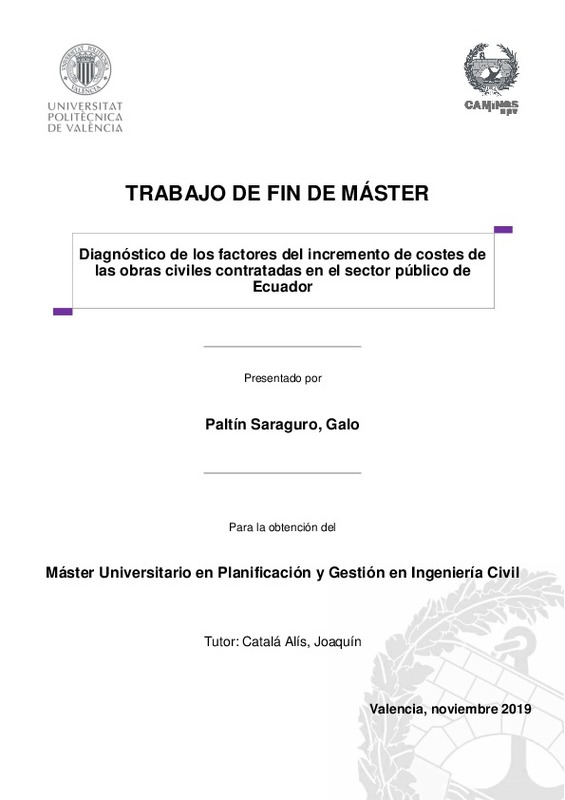|
Resumen:
|
[ES] Este estudio del diagnóstico de los sobrecostes de las obras públicas ecuatorianas se desarrolla en dos partes, una teórica y otra empírica. La parte teórica comprende el estudio del estado del arte, mediante la ...[+]
[ES] Este estudio del diagnóstico de los sobrecostes de las obras públicas ecuatorianas se desarrolla en dos partes, una teórica y otra empírica. La parte teórica comprende el estudio del estado del arte, mediante la revisión de la literatura relacionada con el desempeño de los costes en los proyectos de construcción y los sobrecostes que se generan. Esta revisión proporciona las características esenciales de los costes, así como los factores, causas y teorías que intentan justificar los excesos de costes en la ejecución de las obras. La parte empírica de la investigación se constituye en el punto de partida para el análisis del desempeño de los costes en las obras de la administración pública ecuatoriana. Se elabora una base de datos de las obras ejecutadas por la administración pública durante los años 2016-2017 y se clasificada de acuerdo a: tipo de proyecto, región geográfica, órgano de contratación, coste estimado, coste adjudicado, coste final, plazo, prórroga, duración, entre otros, comprendidos por 60 proyectos de infraestructura de las diversas instituciones de gobierno de Ecuador. Mediante análisis estadístico de los datos, se evalúa el desempeño de los costes y los factores que influyen en su comportamiento. Los resultados de este estudio tienen relación con otros disponibles en la literatura y se contraponen en ciertos casos. Entre los hallazgos más importantes se evidencia que los sobrecostes son más frecuentes que los bajos costes, así también que los sobrecostes relativos y absolutos sobresalen en los proyectos de infraestructura sanitaria. Así mismo, la fase en la que se genera una mayor tasa de sobrecostes es la de construcción, sin embargo, la fase previa no está exenta y se evidencia que las ofertas ganadoras generalmente optan por una 'licitación por suicidio' con la finalidad de hacerse con la adjudicación, por lo que los sobrecostes empiezan más allá de la etapa de construcción.
[-]
[EN] This study of the diagnosis of the cost overrun of Ecuadorian public projects is developed in two parts, atheoretical and anempiricalone. In the first one, theresearchof the state of the art ...[+]
[EN] This study of the diagnosis of the cost overrun of Ecuadorian public projects is developed in two parts, atheoretical and anempiricalone. In the first one, theresearchof the state of the art is developed, reviewing literaturerelated to the performance of costs in construction projects and the cost overruns that are generated. This review provides the essential characteristics of the costs, as well as the factors, causes and theories that try to justify the excess costs in the execution of the works.On the other hand, the empirical part of the research constitutes the starting point for the analysis of the performance of the costs in the works of the Ecuadorian public administration is presented. This analysis is carried out based on the data of the works executed by the public administration during the years 2016-2017. The database was classified according to its own parameters for each project, such as: type of project, geographical region,contracting authority, estimated cost, awarded cost, final cost, term, extension, duration, among othersand it is comprised of 60 projects of infrastructure of the various government institutions of Ecuador.The results found in this study are related toothersavailable in the literature and in certaincases theyarecontrasted. Among the most important findings itisevident that the cost overruns are more frequentlythan the low costs, besides thatrelative and absolute costsoverruns standout in the projects of sanitary infrastructure. In the same way,the phase in which a higher rate of cost overruns is generated is that of construction, however, the previous phase is not exempt and it is evidenced that the winning offers generally opt for a “suicide tender” in order to be made with the award, so the cost overruns begin beyond the construction stage.Finally, to date, an analysis of the cost overruns in the works executed by the government administrations of Ecuador has not been documented, so this study can be considered pioneer in the country, becoming it the baseline to elucidate in future investigations theperformance of the costs in the works, besidesthe factors and measures of mitigation of the excesses.
[-]
|






